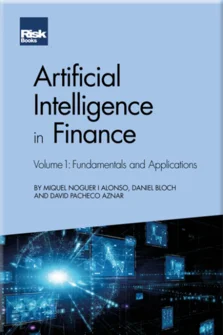The ‘AI in finance’ framework
Miquel Noguer i Alonso, Daniel Bloch and David Pacheco Aznar
The ‘AI in finance’ framework
4.1 THE MODELLING FRAMEWORK IN FINANCE
Artificial intelligence (AI) has become a critical component in the finance modelling framework as it allows for more accurate and efficient analysis of financial data. This has led to the development of various AI-powered models and frameworks that can process large amounts of data and deliver valuable insights. This chapter gives an overview of an AI-powered finance modelling framework, consisting of six main components (Figure 4.1).
Data collection and preprocessing. Gather relevant financial data, such as historical stock prices, financial statements, market indicators and news articles. Preprocess the data by cleaning, standardising and transforming it into a format suitable for analysis.
Feature extraction and selection. Extract relevant features from the data that can help in predicting financial outcomes. Some common features include financial ratios, moving averages and technical indicators. Use techniques such as correlation analysis, mutual information or wrapper methods to select the most important features for the model.
Model selection. Choose the appropriate AI algorithm for the task at hand. Some popular choices in finance include
Copyright Infopro Digital Limited. All rights reserved.
As outlined in our terms and conditions, https://www.infopro-digital.com/terms-and-conditions/subscriptions/ (point 2.4), printing is limited to a single copy.
If you would like to purchase additional rights please email info@risk.net
Copyright Infopro Digital Limited. All rights reserved.
You may share this content using our article tools. As outlined in our terms and conditions, https://www.infopro-digital.com/terms-and-conditions/subscriptions/ (clause 2.4), an Authorised User may only make one copy of the materials for their own personal use. You must also comply with the restrictions in clause 2.5.
If you would like to purchase additional rights please email info@risk.net









